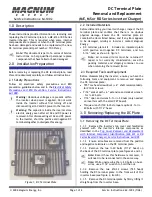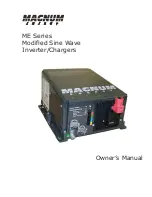
Troubleshooting Guide
499
uses less power than is supplied by a single circuit from your premises’ wiring (generally 10-15 amps in
residential installations and 20 amps in commercial installations).
It is usually a bad idea to put some devices in your system on a power conditioner and other devices on
a separate strip, socket or conditioner, unless you have a technical ground. The power conditioner can
introduce a ground differential.
The power supply provided with Mac laptops does not have a hard ground. This means that if the laptop is
plugged in, it will dump high frequency buzz into the ground. That ground is shared with the 3d USB cable.
If a 3d device will be connected unbalanced to other audio gear, the ground buzz can contaminate the
signal if the 3d device is not hard-grounded to the same ground as your other audio gear. To hard ground
the 3d device you will need to use a 3-pin power cable on the 3d device power supply and power the
3d device with the power supply. Plug the 3-pin IEC power cable into the same circuit and same ground
as your other gear.
Note that unlike USB, the Ethernet connection is galvanically isolated (e.g. transformer coupled) and dis-
connects the ground between the devices at the two ends of cable. As a result any connection made via
MHLink cannot introduce a ground loop, and in the case of connecting to the computer, fully isolates the
audio ground from the computer ground.
On the other hand, if you are encountering ground loop problems while operating with the 3d device’s
power supply, you may find that lifting the device’s ground resolves the problem. This can be accomplished
by using a 2-Pin IEC cable (without the third ground pin), or by using a ground lift block (generally avail-
able in hardware stores, also known as a 3 pin to 2 pin converter). In general, it is better to resolve the
fundamental grounding problems in your system, but this is a quick fix that may help. There are no hard
and fast rules for solving this type of problem other than fixing the fundamental grounding issues, so if
you go this route, you will have to experiment with lifting various grounds in your system until you find the
magic combination. Or switch to balanced interconnects.
Firmware update problems
Details on updating the firmware of 3d Devices are available in the
It is possible for firmware updates to “not take”. This appears to be related to DSP loading issues in the
3d device, other devices on the USB bus (if connected via USB), and the state of the USB system software
on the Mac. If you have problems with updating the firmware, try the following procedure:
1. Remove all devices from the USB bus
2. Power down the 3d device
3. Reboot your computer
4. Power up the 3d device
5. Run the firmware update
In cases where a firmware update to an MHLinked device does not seem to have registered, just run the
firmware update procedure again, making sure to fully power down every box on the MHLink chain for a
good 20 seconds before bringing them all back on-line.
Since 3d devices implement safe-boot and safe firmware update, you should always be able to use this
procedure to update the firmware, even if something goes horribly wrong (like losing power during an
update).
Содержание 3d Upgrade Board Set
Страница 1: ...Metric Halo 3d Users Guide...
Страница 111: ...2882 Specifications 171...
Страница 183: ...Installation and Registration 183 Figure 9 7 Security Privacy Privacy tab Allow MIOConsole3d access to Microphone...
Страница 456: ...The DSP Toolchest 456 Parameters F 10 20k Sets the crossover frequency in Hz of the bandsplit...
















































